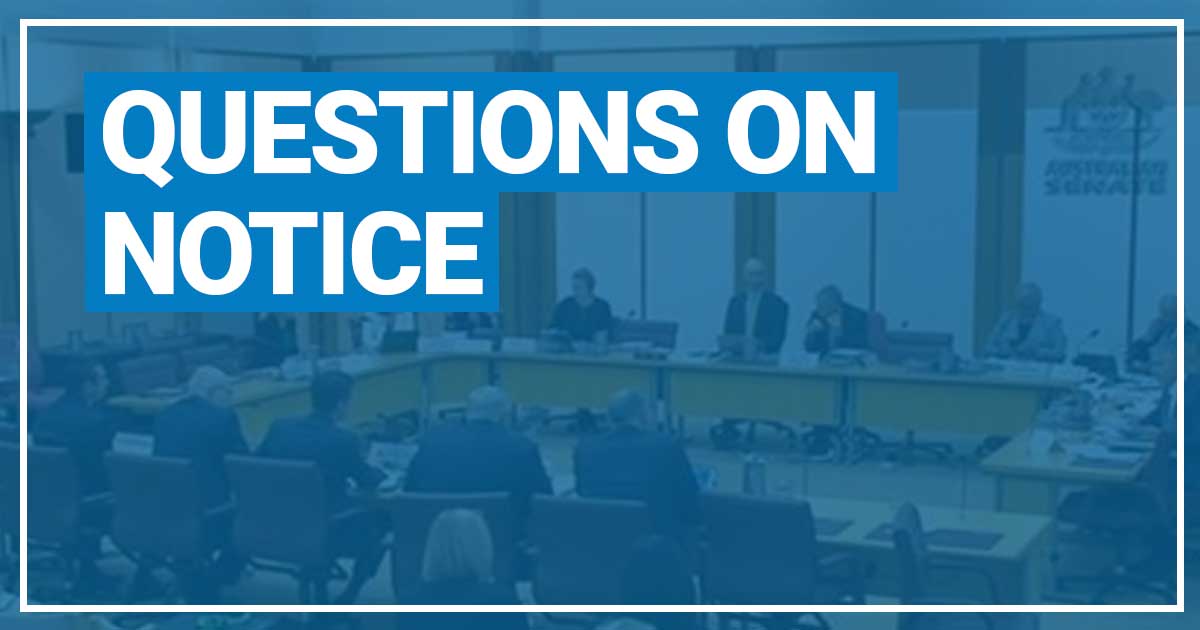Senator RENNICK: Okay. On the National Highway, Gore Highway and Newell Highway, as you may well know, that’s on a lot of black soil country. There have been a lot of heavy rains there in the last year or so. Who’s responsible when it comes to national highways for general repairs and maintenance? Because of all of this rain now, it’s just littered with potholes. You’ve got a highway here with big semis travelling on it. As I’m sure Senator Sterle will know, in times of emergency, which is what I consider this to be, that road is dangerous right now. Along the whole Newell Highway, you might be doing 110 down the road and you hit a pothole that’s half the size of a volcano. Is there anything being done to look at repairing those roads? Sorry about my ignorance; my question is: how much of that is a federal-state maintenance issue? Mr Meagher: The short answer is that maintenance is the responsibility of state and territory governments. The Australian government provides maintenance funding for roads that are on the National Land Transport Network. Senator RENNICK: Yes, which these are. Mr Meagher: We provide $350 million annually, Senator. Senator RENNICK: For the entire national Mr Meagher: Correct. Senator RENNICK: That’s split up by Mr Meagher: Yes, by jurisdiction. Senator RENNICK: Is that prorated on kilometres of road or population? Mr Meagher: It’s based on the road network, I believe. I am happy to take that on notice and confirm it.

Question Number: 205 PDR Number: SQ22-000785 Date Submitted: 07/11/2022 Department or Body: Department of Infrastructure, Transport, Regional Development, Communications and the Arts The principle that funding of maintenance on the National Land Transport Network is a joint responsibility is established in the National Partnership Agreement on Land Transport Infrastructure Programs, publicly available on the Federal […]
Senator RENNICK: That is fair enough. I am curious because the GenCost report is often used as the basis to say that renewables are cheaper. But there’s actually a lot of what I consider flawed assumptions in there, one of them being that you don’t need any more transmission lines until renewables hit 50 per cent of the grid and there’s no recycling costs taken into account. So that is a comment. You don’t need to respond to that. In terms of all the transmission lines that you need to get built between now and 2030 to get to 82 per cent of renewables, have you got approvals for all that from the various landholders? CHAIR: Senator Rennick, I wonder whether Ms Brunoro will take this on notice. There is a lot of detail in what you are asking. Senator RENNICK: Well, we’re in estimates. That is what it is all about—asking for the detail. CHAIR: But rather than her sitting there and adding everything up from her notes, would you be happy to take that further detail on notice? Senator RENNICK: What I would like to know is how far progressed you are in terms of getting the relevant and required approvals from both landholders and state governments and various other bodies—national parks or whatever it may have to be—in order to get those transmission lines built by 2030. Ms Brunoro: The short answer I will provide is that those projects are at different stages of development and approval out to 2030. Some of those that are slated to be delivered in the latter part of the decade will be going through the engagement and consultation processes at a later point in time. Clearly, some of those arrangements are going to change with respect to the various landholders when we get there. We can let you know which projects have had engagement with the community and which ones are to come.

Question Number: 69 PDR Number: SQ22-000199 Date Submitted: 07/11/2022 Department or Body: Department of Climate Change, Energy, the Environment and Water The Australian Energy Market Operator (AEMO)’s 2022 Integrated System Plan (ISP) is a comprehensive roadmap for the National Electricity Market (NEM) out to 2050. Under the step change scenario in the ISP renewables will […]
Senator RENNICK: Thank you. In order to get to the 43 per cent reduction by 2030, how many kilometres of transmission lines will need to be built? What will the cost of that be? Mr Dyer: I might consult. Ms Brunoro: We have to bear in mind that is a national target as well. The integrated system plan covers the eastern states. We can come back to you with some more analysis on that. Senator RENNICK: Didn’t you just legislate it? Hasn’t it been legislated now, the 43 per cent reduction by 2030? CHAIR: I think the answer, Senator Rennick, is that the transmission piece you are discussing is not the totality of the elements that will go to achieving the plan. Senator RENNICK: The reason I am asking is 2030 is only eight years away. My understanding is you have to get to 82 per cent renewables on the grid to get your 43 per cent reduction in CO2. Surely we must have a pretty clear plan and strategy in terms of how many transmission lines need to be built between now and 2030 to hook up enough renewables to get it into the grid, which is just eight years away. Ms Brunoro: Yes. We do. I’m happy to table some information about those key projects. Obviously, Marinus is one of them. There has already been an announcement on that. Senator RENNICK: How many kilometres of transmission lines will that involve? Ms Brunoro: Bear with me. I will have to add that up for you. I note that is a point in time estimate as well. Since the integrated system plan has come out, Queensland has already announced their energy security plan. They will be investing in significant transmission. I can give you a breakdown of the number of kilometres per the actual projects as it stands now and that are underway. We can add that up. Senator RENNICK: And that will get to 82 per cent renewables by 2030? Ms Brunoro: The projects we have in train do align with the projects that are in the integrated system plan, a step change scenario. That estimate from the Australian energy market operator is that it will deliver about 83 per cent renewables by 2030. So it is in line. Senator RENNICK: You can put a cost to that as well? Have we got an estimated cost of that? Ms Brunoro: We can pull out the estimated costs of those projects as they are going through the regulatory impact tests at the moment. Senator RENNICK: Sure. Ms Brunoro: And give a breakdown of them.

Question Number: 68 PDR Number: SQ22-000198 Date Submitted: 07/11/2022 Department or Body: Department of Climate Change, Energy, the Environment and Water Under the step change scenario in the Australian Energy Market Operator (AEMO)’s 2022 Integrated System Plan (ISP), the renewable share of total annual generation is projected to increase to 83 per cent by 2030-31. […]
